How to Build Your Own Audio Streaming Hosting Platform
Today, audio streams, podcasts and music streaming services are big business. As an example, 42% of Americans listen to a podcast each month. They provide a fantastic way to build genuine connections with target audiences and share information in an easy manner. Along with the preference and portability of audio streams, they can prove a phenomenal method of building a brand or business.
A significant advantage of streaming audio files, streaming of music videos and other forms of audio is that people can listen live or on-demand in their own time. Additionally, they can listen from almost anywhere with today’s mobile devices. Especially for those in music, making music available to stream is essential today to build your brand.
In this article, we’ll cover audio streaming in detail. We’ll look at some of the most popular music streaming services such as Apple Music, YouTube Music and Amazon Music. We’ll go into what you need to know to successfully deliver audio content through an audio streaming platform or music streaming service. We’ll also look closely at two types of audio streaming, the best places for audio stream hosting, monetization options, how to host a high-quality stream and more.
Table of Contents
- How to Create an Audio Streaming Website
- High-Quality Audio Streaming
- Where to Upload and Host Your Audio Steam
- How to Monetize Your Audio Streaming
- On-Demand vs. Live Audio Streaming
- Analytics for Podcasts
- Features to Consider When Creating an Audio Streaming Platform
- Most Popular Music Streaming Services
- FAQs
- Conclusion
This article reviews key topics you might overlook if you’re new to the game.
Let’s get started!
How to Create an Audio Streaming Website
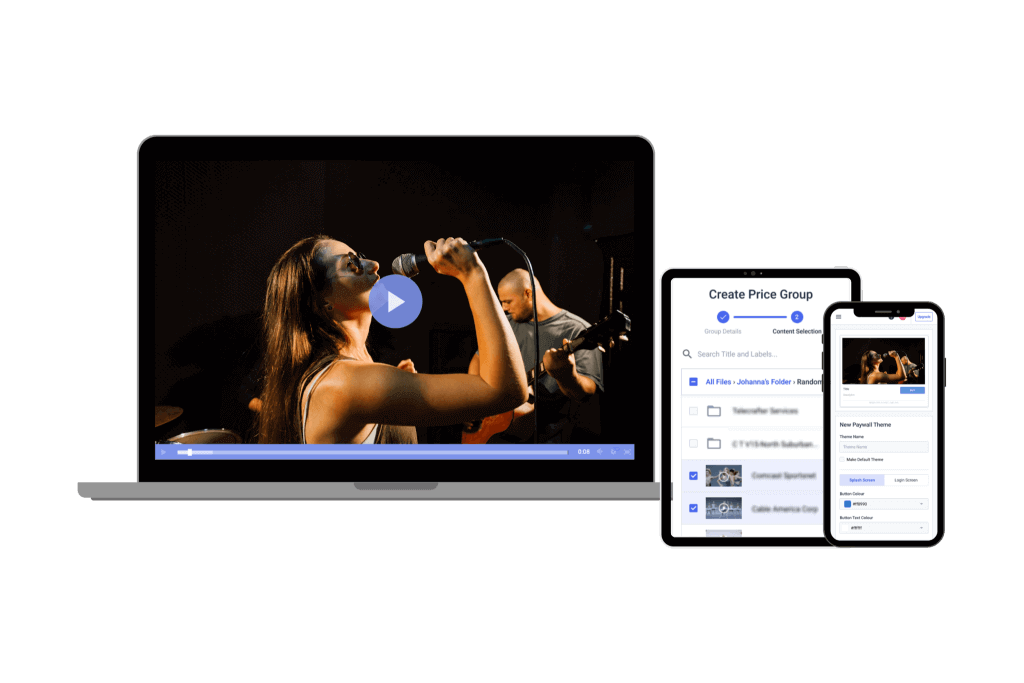

Creating an audio streaming website is as simple as embedding your podcasts or radio show stream on your hosted website with a simple HTML embed code.
Podcast and radio hosts like Anchor, Apple Podcasts, and the like are great options for beginners with low budgets, but embedding and hosting your audio streams directly on your website is the best way to share audio online.
It gives you total ownership of your content and eliminates any rules or community guidelines that could hold you back from creating the audio streams you want.
We will use Dacast as our example of how to build an online audio sharing platform. This process and concept should be similar if you host your content on another platform.
Remember, if you’re here to learn how to make a live podcast or the best music streaming service, not all video platforms and music streaming services support live audio and 24/7 broadcasting. Dacast does. With that said, let’s go over how to create an audio-streaming website.
1. Choose a Hosting Provider and CMS
To start with, you need a website where you can embed your audio player. If you don’t have a website yet, two popular website hosting services are GoDaddy and Bluehost.
Both website hosting services work well with WordPress, one of the most used website content management systems (CMS). With WordPress, you get to design the layout of your website.
2. Choose an Audio or Streaming Music Service
Next, you need a music or live audio streaming platform. Again, there are many audio and music streaming platforms, or you can work with a professional video platform that offers audio-only capabilities.
One of the top reasons why you may want to use a professional video platform is because it can offer you a wide range of tools that can allow you to grow your business, such as:
- Broadcast audio 24/7
- CDNs
- Live audio streaming
3. Log in to your Dacast account
Again, we will just continue using Dacast as an example of simplicity.
Once your audio streaming website is ready, embedding your audio stream is pretty easy, especially if you’re hosting audio streams with Dacast.
When logged into your Dacast account, you’ll look for your list of live channels.
- Then click on the audio channel or audio file you plan to embed on your website.
- On the next page, you’ll click “Publish Settings.”
- Two embed codes are in the lower-left section: iFrame and JS (Javascript). We recommend the JS embed code.
Here is also where you’ll find a share code, which is just a simple URL, to share with your following.
4. Embed the Audio Player Onto Your Website
Copy + paste the embed code onto your website. For example, most online radio stations embed a player at the top of their website. Alternatively, you can embed it on partner websites.
These are the simple steps to transmit audio over the internet using your audio streaming platform.
High-Quality Audio Streaming
Now that you have your website set up, let’s talk about how to stream live audio of quality specifically. In this next section, we’ll dive deeper into encoding settings.
In 2023, AAC will provide the best music streaming service option with high-sound quality streaming for most situations. Many people are familiar with MP3, so we’ll compare AAC to that to give you a better idea. Compared to MP3, you’ll generally achieve the best live audio quality streaming at similar bitrates. However, you’ll find the difference more obvious when streaming at lower bitrates (<128 kbps).
With that in mind, audio streams at Dacast are encoded using the high-quality AAC codec and delivered via HLS streaming protocol. That means the stream can be accessed on any device.
Encoding Your Audio Files.
Depending on your goal, you should encode your audio files at different sound quality levels. Here are some basic recommendations:
- Low Quality(Smallest File Size): 32-64 kbps, mono, 44100 Hz
- High Quality (Medium File Size): 128-192 kbps, stereo, 44100 Hz
- Excellent Quality (Larger File Size): 256-320 kbps, stereo, 44100 Hz
For simple voice conversations, the first option may be fine.
For music, you will want to go with option 2. If high-sound-quality streaming is your number one consideration, choose option 3.
To deliver high-quality live audio streams through your music streaming service, Dacast is the most popular streaming platform option since it allows you to stream live audio in multiple bitrates. This functionality considers your listener’s internet speed and automatically serves the best quality.
Next, let’s explore two of the encoder settings more in-depth.
Mono vs. Stereo: Recommended Channel
Let’s quickly discuss the two possible channels: mono vs. stereo. You’ll find this under encoding settings.
Generally, you’ll want to choose stereo for high audio quality for your music streaming service.
There are rare exceptions where you’d want to consider mono, such as if you plan to sing or play an instrument solo, but stereo is the most common nowadays for playing music on streaming services.
Mono Audio
Mono audio is when only a single sound signal is sent to all the speakers. With mono audio, the sound often seems narrower and more unclear.
Stereo Audio
With stereo audio, two audio signals are sent out, one to teach a set of speakers using two different channels. One sends information to the left speaker and another to the right speaker.
You can create a feeling of directionality, perspective, and space with stereo channels.
Stereo audio is better for the average listener as it produces wider and more realistic sounds.
Audio Sample Rate
Generally, the higher the audio sample rate number, the fuller the sound. However, the larger the number, the more data that is used. That might not be the best option for a free streaming service.
For this reason, we recommend 44.1 Khz (same as 44,100 Hz) as the audio sample rate for high-quality audio for most mobile apps and music streaming services, especially when live streaming. Again, there are exceptions, but for a professional audio or music streaming service, 44.1 kHz is most commonly used.
Audio Server
Also known as music servers, an audio stream server is a software or digital system designed to store and transmit a large capacity of music file libraries. An audio streaming server can either be a physical server or cloud storage.
- Physical Server: These help you organize, store, and distribute audio content to other devices. A physical live audio streaming server is a secure and reliable option that is great for streaming sites with consistently high load.
- Cloud Storage: On the other hand, you can go for cloud services like Cloud CDN or Amazon S3. These cloud storage options allow you to transmit audio data faster than physical servers.
Where to Upload and Host Your Audio Steam
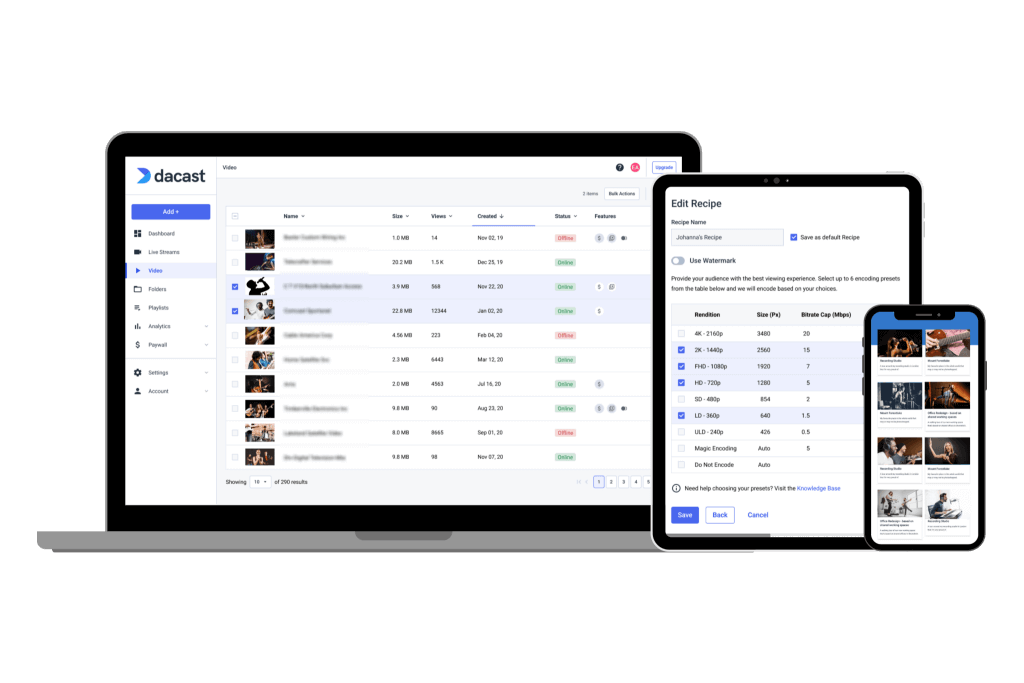

When streaming audio, use a professional platform to host audio files for streaming.
With the rising popularity of online broadcasting, countless businesses in diverse sectors are getting involved in audio streaming. These include education, entertainment, comedy, sports, classical music, news, business, and religion.
Despite their different industries, these businesses face similar technical challenges regarding podcasting. Most notably, where you host your audio files for streaming is important. Most audio streamers choose to use streaming media hosting platforms.
With the differentiation between live audio streams and on-demand streaming, let’s consider the benefits of dedicated streaming solutions. Your streaming solution, an online video platform, is where you can host your audio content.
One major advantage of an online video platform like Dacast is native support for live streaming audio. Most podcast hosting and music streaming services center around hosting and delivering pre-recorded content. They don’t support live broadcasts at all.
In contrast, streaming platforms with audio hosting capabilities like Dacast provide functionality and power for live streams. So if you’re looking for a music streaming service so that you can perform live, you should consider Dacast.
Dacast supports both scheduled events and 24/7 broadcasting. And since the content lives in your video CMS and is distributed via a powerful live-streaming CDN (Content Delivery Network), you can scale to a large, global audience without buffering or lag problems. Dacast also offers a multi-CDN solution for very large or important events where you don’t want to risk your stream getting cut off.
Dacast also supports three types of monetization: ad-based, subscription, and pay-per-stream.
Another thing to keep in mind is that many podcast hosting, mobile apps, and music streaming services offer only limited storage. Often, they offer less than 1 GB per month—and sometimes just 100 MB or even less. Dacast offers 50 GB of storage for just $39 per month with our Starter plan. That’s enough storage for hundreds of podcasts encoded at very high quality.
Therefore, for music streaming services that stream a lot of audio or share super high-quality music files around, Dacast may be the best choice. Dacast also offers the ability to purchase extra storage if needed and allows for automatic overage protection if your podcast goes viral. Additionally, you can protect audio streams with passwords when you want to limit your listeners.
How to Monetize Your Audio Streaming
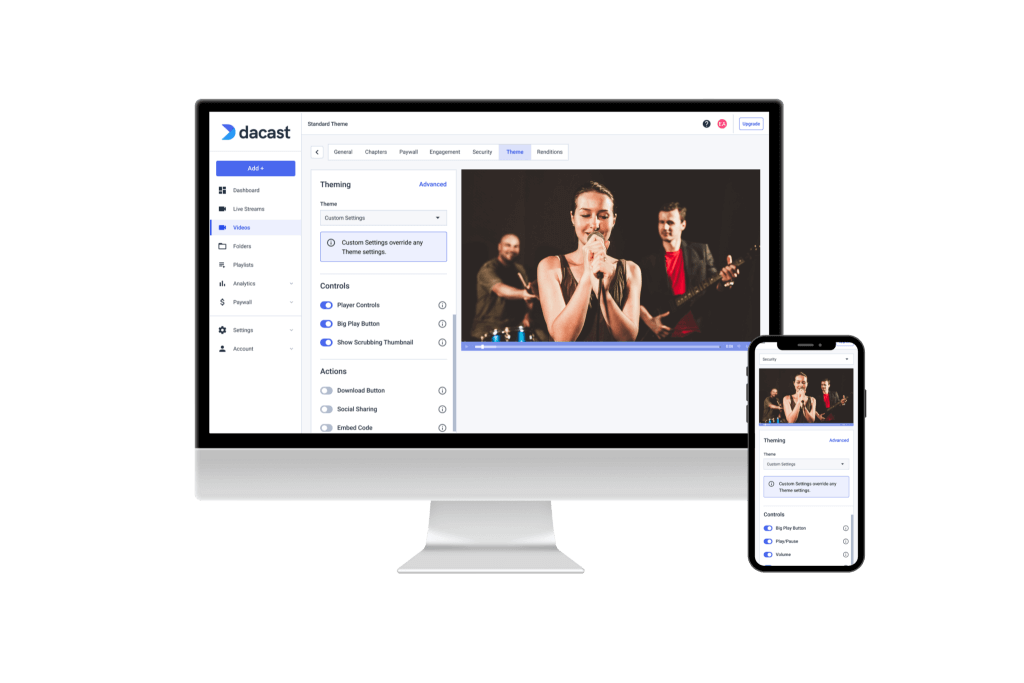

Audio content creators have several options for monetizing their audio streams.
The next section is for those wondering, “Can you monetize a podcast or music service?” In short, the answer is definitely yes.
Some of the best music streaming services within the music industry, including Apple Music, Amazon Music, and YouTube Music, use monthly or yearly subscription methods to monetize their services. Some offer tiered subscription plans through which listeners can access a lossless version or CD quality of music tracks.
Other services offer features that let subscribers play songs from their own music library or on music apps, listen to unlimited music offline, and make, download, and share curated playlists.
As podcasts become more popular, revenue from this type of streaming music discovery is booming. It’s projected to keep growing by 31.1% year over year from 2021-2025.
When the concept of podcasts was newer, the idea of how to monetize a podcast was still a mystery. Now, in the world of podcasting and online radio, there are three proven ways to approach podcast monetization: advertising, subscriptions, and selling services/products. Additionally, broadcasters can use pay-per-view to monetize a podcast, but this isn’t as common.
Here’s a quick breakdown of how to monetize your podcast.
1. Advertising
One of the top ways of monetizing podcasts is advertising. There are different ways to incorporate advertisements into your content with audio content.
Run Commercials
One of the most common ways to incorporate content is by running commercials on your podcast. You can run audio commercials at the beginning, end, or even in the middle of your content.
Talk about a Product
With podcasts; many hosts will choose to talk about a product by integrating it into the podcast naturally. For example, if you run a health podcast, you may speak of a specific health product, such as talking about a particular type of protein powder.
It can be a natural way to partner with a brand by incorporating their content directly into the podcast. Just be sure to disclose that you have a paid partnership with the brand in the podcast.
Run Ads from Advertising Networks
Another way is to insert ads from the advertising networks. Dacast supports ad insertion with popular advertising networks. That’s one reason why Dacast is one of the best podcast hosts for monetization. Many video platforms do not popularly support advertising.
It’s also easy to copy an ad URL from your ad-serving provider, then paste it into the Dacast backend.
Look for partnerships relevant to your main topic and your ideal audience so it doesn’t seem forced or salesy.
2. Subscription
Another popular way to monetize your content is through subscriptions, where people pay a subscription fee to download or stream your show. You will need a secure paywall for people to pay the subscription fee.
Dacast streaming solution includes a built-in paywall with various configuration options. It supports credit cards and PayPal, as well as multiple currencies. That allows podcasters to launch and monetize premium audio streaming quickly.
Allowing your listeners to subscribe is an excellent way to build a deeper relationship with your audience. You can start building your audience by offering a free trial or a few free podcasts that are value-packed and then offering a subscription to access the rest of your content.
Free Trails
Offering a subscription after a free trial and a few free music streaming services or podcasts is a great way to build people’s interest and get your audience more invested in your content, a technique employed by the best music streaming services.
We live in an age that loves feeling like they’re part of a community, and that’s why so many people happily pay to be a part of communities that many audio platforms and best music streaming services offer, even though so many free options are available.
3. Sell Your Products or Services
Selling your own product or services is arguably the best way to monetize a podcast. In practice, starting by giving your audience free advice surrounding particular subjects is very common for audio platforms and the best music streaming services.
For example, you’re a Facebook ads specialist looking to sell business consulting services. On your podcast, you can take the approach of answering frequently asked Facebook ad questions.
Establishing Your Presence
By doing this, you establish yourself as an authority and one of the best music artists on streaming services in the eyes of your ideal target audience. Once you’ve done enough podcasts and helped enough people, the rest will come naturally.
Scaling Up
If you stick with it, one of your listeners will eventually want to scale up their social media ad spend. When they do, they’ll naturally think of you when they’re looking to hire someone for Facebook ad implementation or consulting. The concept applies to every profession (legal, sales, accounting, etc.).
Remember that you don’t have to go from giving a free trial or free advice or free streaming or free music or services straight to higher ticket sales. Sometimes it helps to have a less costly service or product as a stepping stone. For example, the Facebook ads specialist may want to make a downloadable PDF with 100 proven Facebook ad templates and then sell it for a small price of $9. That way, the podcaster appeals to people with all budgets and goals.
4. Pay-Per-View
Using pay-per-view is another way of monetizing podcasts, audio streams, and streaming music services. A paywall can charge for access per episode, every time a customer wants to play music from their own music or streaming sites, or for access to a series of entire shows.
Again, this is not very popular.
On-Demand vs. Live Audio Streaming
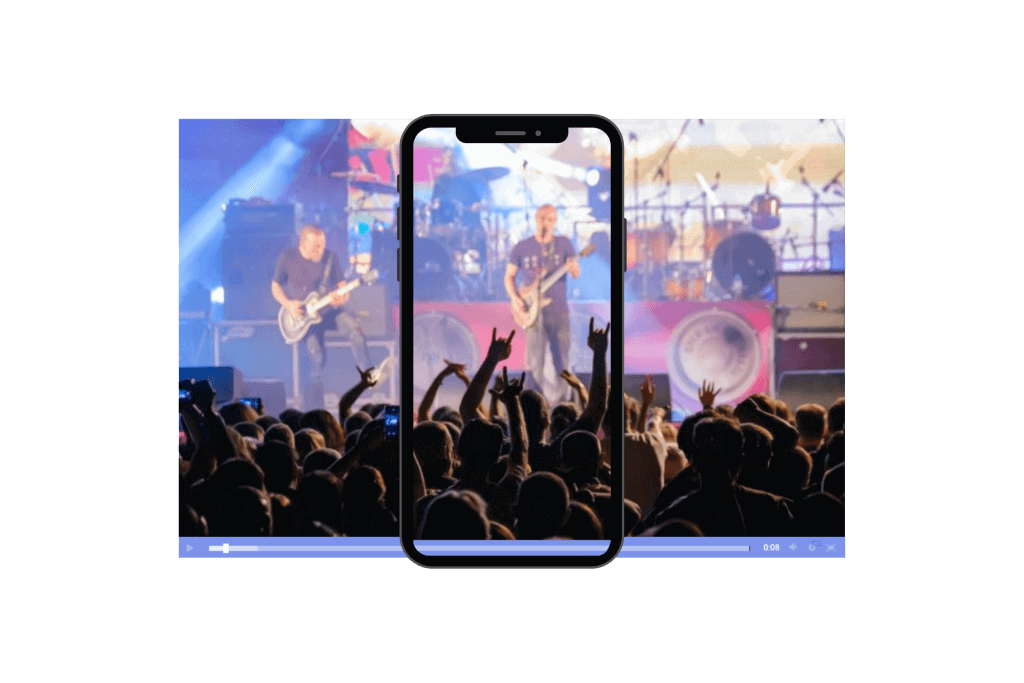

The first step to audio streaming or streaming music services is determining whether you’d like to host podcasts or radio broadcasts.
There are two main types of music online and audio streaming: on-demand and live audio streams.
On-demand is podcast-style audio. Listeners can play an episode at any time. Content is always available in an archive, stored in your video content management system.
The second common type is live audio streaming, like internet radio. Businesses may use live audio streaming for a single event or broadcast, after which they can make the recording available on demand.
Alternatively, you can create customizable channels that can do 24/7 audio broadcasting in the style of linear streaming. That’s the case for online radio.
Both approaches are valuable, and many broadcasters might choose to use them if appropriate for the context.
Analytics for Podcasts
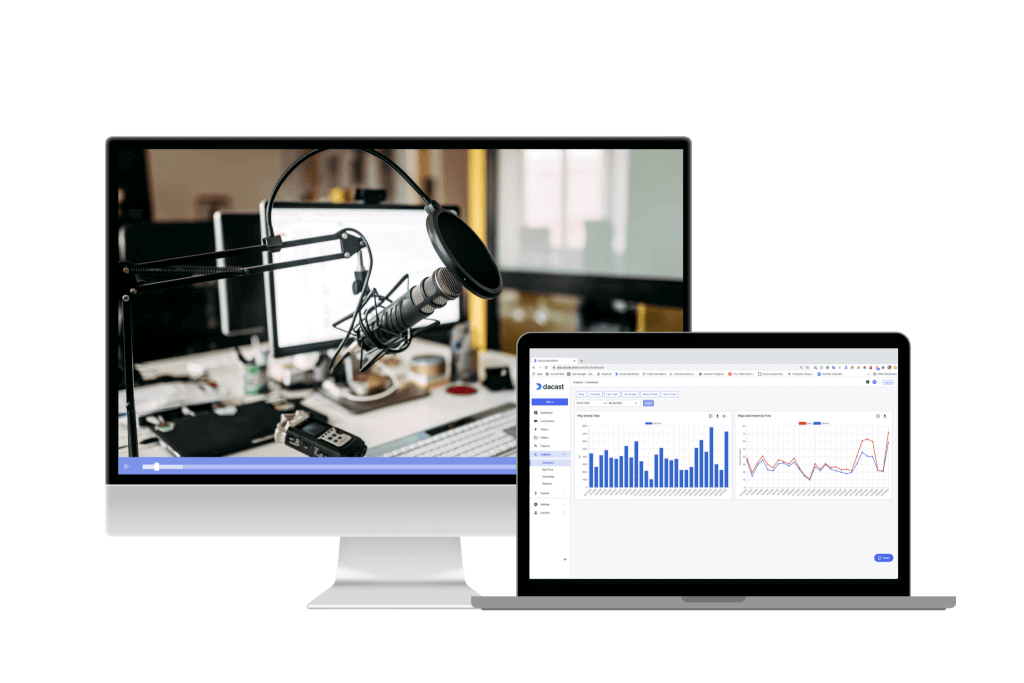

Understanding your audience will help you create more effective content and offer the best music streaming services in the future.
Analytics refers to capturing data about your viewers. You can use this data to help increase the quality of your work going forward.
The most basic analytic data includes:
- Number of listeners
- Listener locations (country and city-level data)
- Average listening time
- Revenue
- Most popular shows
- Most popular device types
- Revenue data, broken down by time, device, and location
- How many users sign up after their free trial period
Dacast also offers innovative real-time analytics. That means that live audio streamers can get real-time information about audiences as they broadcast over the internet, which is pretty valuable.
How to Use Analytics (Examples)
Let’s go more in-depth on ways to put analytics into action.
One way to use analytics is to see where most of your listeners live. For example, seeing many of your viewers from New York City(NYC) is helpful to explore. Why is a lot of your traffic coming from NYC? Maybe an influencer in the area shared your podcast. Or perhaps your humor just really resonates with people from NYC. You can learn a lot about your audience by diving into analytics.
To take it a step further, since people in NYC like your music service or podcast, you can consider running ads in the area to advertise your podcast further.
Let’s use another example. Say you are getting a lot of traffic from Nashville, Tennessee, but for some reason, you’re making more revenue from NYC, where you have less of a following. Now you know to spend more time and money advertising to people in NYC because it’s proving to be a higher return on your investment.
Of course, your specific decisions will differ depending on your goals and your main monetization strategy.
Features to Consider When Creating an Audio Streaming Platform
A good audio streaming platform should be equipped with features that create a seamless listening experience for users. Here are some of the most important ones to consider:
- Search Bar: Create a search bar that enables listeners to easily find particular songs, podcasts, and other audio content.
- Playlists: Make it easy for listeners to organize their favorite audio content into playlists.
- Offline Mode: Provide a level of offline access that allows users to listen to selected audio files even when they are offline.
- Suggestions: Use a recommendation engine to suggest trending music, podcasts, and other audio content your listeners may like.
An Overlook of The Most Popular Music Streaming Services
After learning how to launch your audio-streaming website and music apps, let’s look at some other music streaming services, such as Apple Music, YouTube Music, and Amazon Music Unlimited.
Apple Music
Thanks to its feature-rich offerings, such as the option to stream music in CD quality, curated playlists, and many Apple music tracks, Apple Music is a popular choice among music lovers internationally. Apple TV, Apple Music, and its music streaming app also offer podcast-style live radio shows and exclusive content that keep listeners hooked.
It’s also been recently updated to include incredible spatial audio for an even higher-quality audio experience. Moreover, the ability to stream lossless audio and hi-res audio streams while you play music makes this the right music streaming service for many.
Amazon Music
While the basic Amazon Music is a free perk of being an Amazon Prime member, Amazon Music Unlimited is free tier an upgrade many Amazon Music fans chose to pay extra for. Unlike Apple Music, limited to Apple users, Amazon Music and Music Unlimited work on ios and android mobile devices.
Amazon Music offers offline listening, access to new music releases, voice commands, and exclusive podcasts.
YouTube Music
As a comparatively low-priced music streaming service, YouTube Music offers features such as new music releases, personalized playlists, recommendations, and the option to stream music offline. YouTube Music’s family plan is excellent if you and your loved ones love streaming music on multiple Android devices.
FAQs
1. Is There a Free Music Streaming Site?
There are several music streaming sites that give you access to some or all of their music content for free. The most popular free music streaming sites include:
- YouTube Music
- Spotify
- Jango
- SoundCloud
- Deezer
- Freefy
- Pandora
- iHeartRadio
2. How Much Does it Cost to Create a Music Streaming Platform?
The cost to set up a music streaming platform depends on the size of the platform, level of customization, and the type of technology you use. The average cost falls between $10,000 and $25,000.
3. What is an Audio Streaming System?
Audio streaming refers to the process of playing music files or transmitting audio content in real-time without the need to download it. Therefore, an audio streaming system allows users to stream live audio content wirelessly by connecting to a streaming service app over the internet.
4. Can You Make Money When You Stream Your Own Music?
With a platform like Dacast, you can monetize your audio streams by incorporating brand commercials, charging subscription fees, or charging listeners per stream.
5. How to Build a Music Streaming Website Like Spotify?
If you want to create a music streaming website like Spotify, you must:
- Acquire licenses and authorization to stream music content
- Choose a music website developer
- Create an audio streaming site design
- Test and deploy the audio streaming site
- Implement post-launch maintenance to ensure that it keeps running smoothly
Conclusion
Audio streaming and the digital music streaming industry will continue to grow. It is an increasingly popular method of distributing content and growing brands. Apple Music, YouTube Music, Amazon Music Unlimited – these are all fantastic platforms. But there are also platforms that cover more of a creators’ base.
Dacast is a professional and established platform that will cover all your streaming needs. With Dacast, you can broadcast high-quality audio, monetize your audio content and build your brand. What’s more, it’s secure, seamless and easy to use.
You can try Dacast and all its features completely free for a full 14 days. Take advantage and experience a professional-grade streaming platform today.

 Connect
Connect
 Events
Events Business
Business Organizations
Organizations Entertainment and Media
Entertainment and Media API
API Tools
Tools Learning Center
Learning Center Support
Support Support Articles
Support Articles